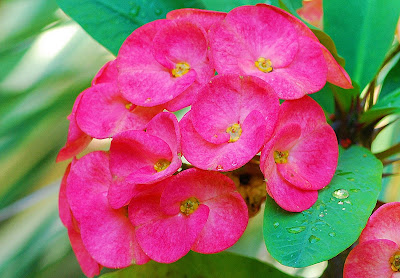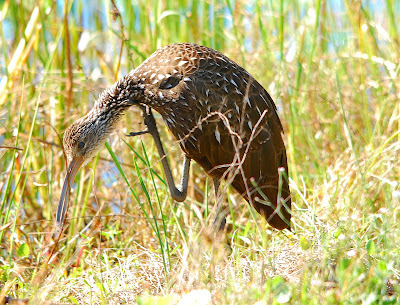With great anticipation, I made my sixth trip to Harns Marsh Preserve in Lehigh Acres, Florida today.
 The birds above were photographed at Harns Marsh Preserve in November 2009.
The birds above were photographed at Harns Marsh Preserve in November 2009. The correct spelling of the preserve is a mystery to me as the Caloosa Bird Club identifies it (with directions to the preserve
here)as Harnes Marsh.
I was unsure of what the lighting conditions for photography would be. As was the case on prior visits to the preserve, the sky was somewhat overcast with intermittent high clouds today.
 The Bald Eagle above was photographed at Harns Marsh Preserve in November 2009.
The Bald Eagle above was photographed at Harns Marsh Preserve in November 2009. This made for less than ideal conditions where I would prefer consistent bright light. This allows the chance for better imagery at a greater distance.
The temperature was 44 degrees Fahrenheit upon my arrival. The relative warmth of the water created a heavy mist on the marsh that burned off quickly once the sun had risen over the trees.
 The Boat-tailed Grackle above was photographed at Harns Marsh Preserve in November 2009.
The Boat-tailed Grackle above was photographed at Harns Marsh Preserve in November 2009. It was my initial intent to walk around the preserve as I had on my last visit, but there was enough action in the vicinity of the parking area to keep me busy observing what was immediately accessible.
Not to mention, I wasn't rested enough for the journey that can be daunting.
 The Wood Stork above was photographed at Harns Marsh Preserve in November 2009.
The Wood Stork above was photographed at Harns Marsh Preserve in November 2009. I thought I had made a sighting of the Snail Kite which I would note as a given at the preserve, but after review of my images taken, the bird I thought was a kite was actually an Osprey. This was the first occasion I have not seen the Snail Kite at the preserve.
I did, however, see a few other species up close I had not seen before at Harns Marsh including the Bald Eagle, American Kestrel, and Killdeer. The latter I was especially surprised by which I would only expect to see at the beach, or at least much closer to it.
 The Double-crested Cormorant above was photographed at Harns Marsh Preserve in November 2009.
The Double-crested Cormorant above was photographed at Harns Marsh Preserve in November 2009. Gayle Schmidt's
checklist for the shorebirds at Harns Marsh is surprising to me with a dozen species observed. The Killdeer made my first sighting of plover at the preserve.
The Limkin was present, but disappointingly silent. I missed its call across the water which is very distinctive.
 The Killdeer above was photographed at Harns Marsh Preserve in November 2009.
The Killdeer above was photographed at Harns Marsh Preserve in November 2009. It was a treat to meet Jerry and Susan, from Naples, whom had made a walk along the Northeastern boundary of the preserve. Upon their exit, they told me that they had observed the merganser which I didn't clarify. I had assumed it was the Hooded, but the Red-breasted has also been observed at Harns Marsh in the past. Susan and Jerry were planning on making a trip to Six Mile Cypress Slough Preserve to observe the smaller birds, as Jerry described them, before heading home.
Before the arrival of the first fisherman to Harns Marsh on this day (I think its only half the time I haven't seen one), I thought I was observing the breach of unusually large fish on the water's surface. After a short while, I realized I was seeing something else.
 The River Otter above was photographed at Harns Marsh Preserve in November 2009.
The River Otter above was photographed at Harns Marsh Preserve in November 2009. As I made my way South, a large River Otter crossed my path within a dozen feet of me. It was quite fast in its effort to leave the marsh, crossing the small ravine to my left, and entering the woods. Since I had observed two of the creatures together in the water, I walked a little further and waited with hopes to see the other otter. After a few minutes, it also made a bee line to the woods, but somewhat cooperatively stayed in the ravine for some portraits.
This was the first occasion I've seen the River Otter. The second otter was significantly smaller than the first I'd seen out of the water but was not as fast. A female or juvenile I'm not sure.
 The Cattle Egret above was photographed at Harns Marsh Preserve in November 2009.
The Cattle Egret above was photographed at Harns Marsh Preserve in November 2009. Across the marsh, at first light, I observed what I thought were Snowy Egrets. Closer inspection identified them as Cattle Egrets.
The highlight of this most recent visit to Harns Marsh, without doubt, was what appeared to be a territorial battle between two Great Blue Herons.
 The Great Blue Heron above was photographed at Harns Marsh Preserve in November 2009.
The Great Blue Heron above was photographed at Harns Marsh Preserve in November 2009. All the other typical wading birds were observed with the exception of the Reddish Egret which I have yet to see at Harns Marsh.
The Osprey were in greater numbers than I've seen before here. They were in the water twice, but not to be photographed.
 The Great Blue Heron above was photographed at Harns Marsh Preserve in November 2009.
The Great Blue Heron above was photographed at Harns Marsh Preserve in November 2009. The Bald Eagle was an unexpectedly observed predator of the marsh. Susan mentioned seeing the juvenile of the species which I did not.
The eagle was harassed by the kingfisher on a couple of occasions.
 The Great Blue Heron above was photographed at Harns Marsh Preserve in November 2009.
The Great Blue Heron above was photographed at Harns Marsh Preserve in November 2009. I also observed the American Kestrel and Northern Harrier, but was not able to photograph them. I considered the harrier too far away to pull the trigger.
The kestrel fought a strong wind from the North where it was virtually still for what was a good 10-15 seconds, but I could not respond quickly enough to get the shot of it. I was more memorized by its presence for half the time than I had to react before it took the wind way out of range.
 The Great Blue Heron above was photographed at Harns Marsh Preserve in November 2009.
The Great Blue Heron above was photographed at Harns Marsh Preserve in November 2009. Another treat in visiting the preserve was my first observation of the Tree Swallow. The species made its way through in a flock of a few dozen. There were some stragglers that allowed for some photographs.
This species, which is extremely fast in flight, reminded me of my challenge in capturing images of even the larger and slower birds I often see.
 The Tree Swallow above was photographed at Harns Marsh Preserve in November 2009.
The Tree Swallow above was photographed at Harns Marsh Preserve in November 2009. Before leaving the preserve, I also met Bob and Denise visiting from England. They had plans to bike the preserve at least in part. This is a recommended way to visit here as the boundary of the preserve is too large for a walk, especially in the summer months.
Bob had told me of his and Denise's trip to San Carlos Bay: Bunche Beach Preserve where a recommendation was made to visit where we were. I, of course, recommended that they visit Little Estero Lagoon, a stones throw from where they're staying.
 The Belted Kingfisher above was photographed at Harns Marsh Preserve in November 2009.
The Belted Kingfisher above was photographed at Harns Marsh Preserve in November 2009. One of my work mates that makes frequent trips to Fort Myers Beach for physical fitness has told me that the bird migrants have arrived. It's been nearly five weeks since my last visit to the beach which seems like an eternity.
In another month or so, a greater diversity of ducks should arrive, when I hope to make my next visit to Harns Marsh Preserve.
 The Double-crested Cormorant above was photographed at Harns Marsh Preserve in November 2009.
The Double-crested Cormorant above was photographed at Harns Marsh Preserve in November 2009. A trip to the beach is a long overdue necessity at this point while I haven't had a recent opportunity with preferred conditions.
There are going to be extremely favorable
low tides at the beginning of next month.
 The Osprey above was photographed at Harns Marsh Preserve in November 2009.
The Osprey above was photographed at Harns Marsh Preserve in November 2009. I hope to visit Bunche Beach Preserve, Little Estero Lagoon, and Tigertail Beach in the coming weeks to take advantage of the better shore birding known.
Before the year ends, I also hope to report from DDNWR. As a reminder, this venue is closed on Fridays.
 The Double-crested Cormorant above was photographed at Harns Marsh Preserve in November 2009.
The Double-crested Cormorant above was photographed at Harns Marsh Preserve in November 2009. I also need to update my pbase galleries of the
Great Florida Birding Trail (where you may click on a venue of interest) from a recent trip across the state.










































 Limpkin scratching at Walsingham Park.
Limpkin scratching at Walsingham Park.

 This pink stuff is apple snail eggs. They lay their eggs above water so the fish don't eat them (that way the limpkins can eat them when they are fully grown). I noticed this big blob at the Circle B Bar Reserve in Lakeland when the dragonfly landed on it. Now I see these blobs at the lakes around here. I guess that's why the limpkins hang out at these lakes.
This pink stuff is apple snail eggs. They lay their eggs above water so the fish don't eat them (that way the limpkins can eat them when they are fully grown). I noticed this big blob at the Circle B Bar Reserve in Lakeland when the dragonfly landed on it. Now I see these blobs at the lakes around here. I guess that's why the limpkins hang out at these lakes.